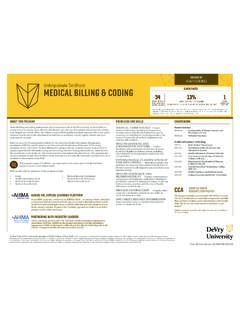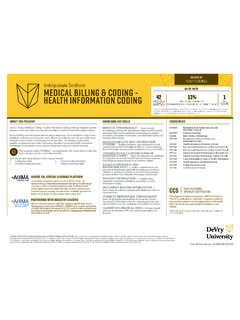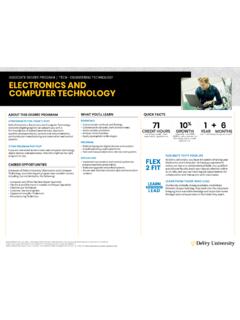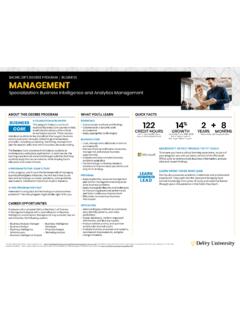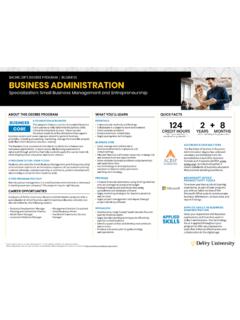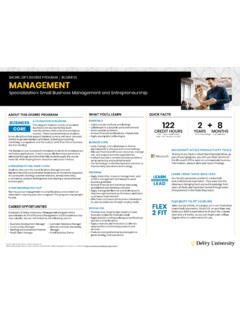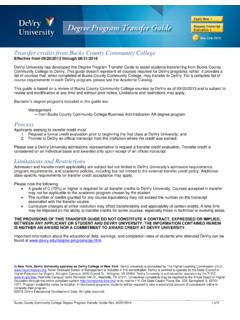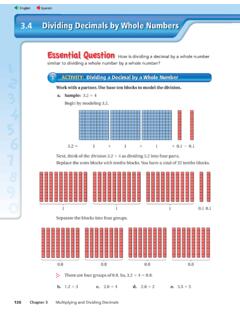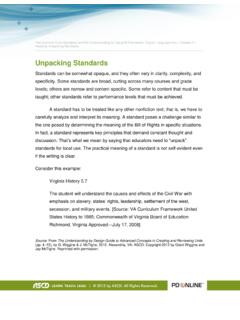Transcription of Undergraduate Assessment Test Study Guide
1 1 In New York, DeVry University operates as DeVry College of New York. Copyright McCann Associates 2019. All Rights Reserved Undergraduate Assessment Test Study Guide October 2019 2 In New York, DeVry University operates as DeVry College of New York. Copyright McCann Associates 2019. All Rights Reserved Test Taking Tips Prepare Take practice assessments and Study areas of weakness. If you need a calculator during practice, use a standard four-function calculator (sample below), which will be available during the Assessment . Read the directions carefully When you take the assessments, make sure to take your time and carefully follow the instructions for each question.
2 Use reasoning when answering 1. Identify the key phrase in the question. 2. Try to find the correct answer before you read all the choices. 3. Eliminate the choices that you know are not correct. 4. Read all the choices and pick the best answer. Review Be sure to review each answer carefully before submitting. You will not be able to go back to any questions. 3 In New York, DeVry University operates as DeVry College of New York. Copyright McCann Associates 2019. All Rights Reserved DeVry Subject Area Tests There are three DeVry multiple choice tests. There is also a written essay portion. The content that is covered in the multiple choice tests are listed below by subject: Arithmetic (25 questions): Integers, Fractions, Decimals, and Percents solve numerical and word problems, and compare magnitudes Ratios compute, identify equivalent ratios, and understand and explain ratio and rate reasoning Irrational numbers identify irrational numbers Exponents evaluate numerical expressions with integer bases and exponents Algebra (25 questions).
3 Expressions, Equations, and Inequalities identify, simplify, evaluate, construct, and interpret Functions identify domains, manipulate, and solve Order of Operations simplify and rewrite numerical expressions Systems of Equations construct a system of equations f rom a word problem Coordinates translate between an equation and a line, including slope Polynomials factor, expand, and perform operations with polynomials Reading (30 questions): Determine what the text says explicitly and what can be inferred logically Support or challenge assertions about the text Discern the most important ideas, events, or information, and summarize them Delineate the main ideas or themes and the details that elaborate and support them Determine when, where, and why events unfold in the text, and explain how they relate to one another Analyze the traits, motivations.
4 And thoughts of individuals Determine what is meant by words and phrases in context Analyze how specific word choices shape the meaning and tone of the text Analyze the text's organizational structure Analyze how specific details and larger portions of the text contribute to meaning Evaluate the reasoning and rhetoric that support an argument or explanation Apply knowledge and concepts gained through reading to expand understanding Create a logical progression of ideas or events, and convey the relationships among them Choose words and phrases to express ideas precisely and concisely 4 In New York, DeVry University operates as DeVry College of New York.
5 Copyright McCann Associates 2019. All Rights Reserved What should you expect? The following section provides an overview of the type of information you will need to know to perform well on the math subject area tests. It is not intended to be a comprehensive listing of all content covered. Arithmetic: You should review your basic math rules such as order of operations, exponents, irrational numbers, and percents. Here are a few of the rules to review: Order of Operations 1. work within parentheses 2. simplify exponents 3. multiply and divide 4. add and subtract Signed Numbers 9 +( 7)= 16 15+20=5 4 ( 5)=9 6 ( 8)=2 3 ( 2) =6 5 ( 2) = 10 15 3 = 5 12 ( 4) =3 Fractions and Decimals 29+39=59 16+34=212+912=1112 78 18=68=34 57 25=2535 1435=1135 12 48=11 28=14 112 23=32 23=11=1 12 16=12 61=11 31=3 212 213=52 73=52 37=1514 14=1 5 In New York, DeVry University operates as DeVry College of New York.
6 Copyright McCann Associates 2019. All Rights Reserved Exponents The mathematical notation that indicates that a variable is multiplied by itself the number of times specified by the exponent. 3= 5= 5 3= 8 ( 5)3= 15 Rational Numbers A rational number is a number that can be expressed as a simple fraction (or ratio) of two integers, and , with 0. , 6, 25, 0. 08 , and are rational because they can be written as simple fractions: 34, 61,51,899, and 13, respectively. Irrational Numbers An irrational number cannot be expressed as a simple fraction (or ratio) of two integers. 2, , and are irrational because they cannot be written as simple fractions.
7 The decimal representations continue infinitely without repetition of a fixed sequence of numbers. Percents The word percent means "hundredths" or a number that is divided by 100. Converting a number into a percent involves multiplying the number by 100. A percent can be determined by performing the division of the part by the total and multiplying it by 100: %= 100 6 In New York, DeVry University operates as DeVry College of New York. Copyright McCann Associates 2019. All Rights Reserved Algebra: You should know how to construct, simplify, and evaluate expressions, equations, and inequalities; solve s ystems of equations; identify features of the graph of an equation; and perform operations with polynomials.
8 Here are a few of the rules to review: Constructing, Simplifying, and Evaluating E xpressions, Equations, and Inequalities When constructing an expression, equation, or inequality from a word problem, break the problem down piece-by-piece until you have addressed each part. Solving Systems of E quations Two common methods of solving a system of equations in two variables are the Substitution Method (substituting one equation into the other) and the Elimination Method (adding or subtracting the equations to eliminate one variable). Identifying Features of the Graph of an E quation The slope of the line = + is . A line that is parallel to this line will also have a slope of.
9 A line that is perpendicular to this line will have a slope of 1 . If given two points along a line, ( 1, 1) and ( 2, 2), the slope of the line is given by = 1 2 1 2. To find the vertex of a parabola, rewrite the equation = 2+ + in vertex form by completing the square: = ( )2+ . The vertex is at the point ( , ). Operations with Polynomials When adding or subtracting polynomials, only like terms can be combined. When multiplying polynomials, multiply each term in one polynomial by each term in the other polynomial. Simplify if necessary. When dividing polynomials, sometimes the polynomials can be factored, and then the common factors between the numerator and denominator will cancel out.
10 Using long division will always work if the polynomials do not factor evenly. 7 In New York, DeVry University operates as DeVry College of New York. Copyright McCann Associates 2019. All Rights Reserved Arithmetic Sample Questions: 1. Choose the fraction that goes in the blank. 12<_____ < 45 A. 13 B. 24 C. 23 D. 56 2. What is the ratio of circles to squares? A. 1 to 3 B. 1 to 9 C. 3 to 1 D. 9 to 1 3. A sweater costs $ plus a 6% sales tax. How much will the sweater cost with the tax (rounded to the nearest penny)? A. $ B. $ C. $ D. $ 8 In New York, DeVry University operates as DeVry College of New York. Copyright McCann Associates 2019. All Rights Reserved 4.
